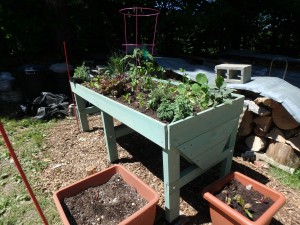It’s Not Too Late to Start an Herb Garden
Garden centers are mostly sold out of flowers and vegetables by now, but there seem to be plenty of herbs still for sale. Now that you have (hopefully) gotten your veggies and annual flowers planted, this is a good time to plant some herbs.
My vegetable garden –where I have always grown herbs – is somewhat remote from my house and down a set of stone steps. But this summer I have an herb garden between my car park and wood pile – just 10 steps or so from the house.
So how do I grow parsley, sage, rosemary and thyme (and others not included in Simon and Garfunkel’s song) in a spot that sounds so inhospitable? I am growing them in a wooden container called a VegTrug that I got from Gardeners Supply (www.gardeners.com). It’s big and deep: six feet long, 2 feet wide and up to 18 inches deep in the middle of the V-shaped container. It is on legs and stands 30 inches high. Very nice, no bending over.
Filling up the VegTrug with appropriate planting mix is important: you can’t just dig garden dirt and shovel it in. The soil would compact and the plants wouldn’t thrive. But it takes over 400 quarts of soil mix to fill this behemoth. To buy that much potting mix would be pricey.
Getting the mix right is important: you want your mix to stay fluffy, hold water and offer nutrients. But if you just used a standard commercial potting mix, your growing medium would need weekly infusions of liquid chemical fertilizer. Adding compost introduces organic matter and beneficial microorganisms that work with the roots of your plants to share nutrients from the compost and organic potting soil.
I buy good quality compost each year that a local contractor makes from cow barn scrapings that he turns and aerates and makes into lovely light-weight compost that is relatively weed free. I mixed that compost with peat moss, “Moo-Grow” (an organic potting soil), organic fertilizer, limestone, perlite and vermiculite.
Vermiculite is a fluffy material made from heat-expanded mica that holds water. It is used in most potting mixes, though you might not notice it. I also added perlite, another heat-expanded mineral. It looks like Styrofoam, but is great for containers: it has a neutral pH, holds water and air, does not deteriorate or compress. I used a total of 6 quarts of each in my VegTrug. Perlite and vermiculite go a long way.
To make my soil mix I used a 5-gallon pail to measure, adding roughly 2 parts of compost and 2 parts of Moo-Gro potting mix to one part of peat moss. I stirred up that mix in a huge garden cart. I added half a cup of limestone per bucket of peat moss to counteract the acidity.
Once the ingredients were mixed, I add Pro-Gro, an organic bagged fertilizer. I used a total of 2 quart containers of Pro-Gro in the 100-plus gallons of soil mix I made. I added one quart of Azomite, a source of diverse mineral micronutrients, in the total mix. Azomite is optional. You could add rock dust instead, if you can get some very fine rock powder from a tombstone maker or a rock quarry. Or you can leave it out altogether.
It is important to get the ingredients well moistened before adding them to the VegTrug. I did this by adding water from my hose to the mix, and stirring with a shovel. Dry peat moss can be very hard to moisten; I wet it, stirred it, let it sit, and repeated until it seemed evenly moist.
So what am I growing? In the middle, where the soil is deepest, I have a tomato plant, one I started from seed called ‘Summer Sunrise’. The seeds came from the Hudson Valley Seed Library (www.seeedlibrary.org and is suited for container growing.
What else? I have about a dozen lettuce plants, 3 flat-leafed parsley plants, 2 kinds of sage, a rosemary and a thyme plant. I dug up a chunk of chives from my garden, cut it back and planted it in the VegTrug. Marjoram and a nasturtium are doing well – the latter has edible flowers, and will flow out and over from the VegTrug.
I planted dill and arugula by seed – both are up and doing fine, though I also bought a small pot of dill at my local Food Coop – another good source for pots of herbs. Lastly I planted a 4-pack of small basil plants. Everything is thriving!
Watering is important for containers. This VegTrug has shallow soil near the edges, deeper soil towards the middle, so the edges dry out quicker. I find I need to give it 4 to 6 gallons in hot, sunny weather. It only gets sunshine from 9am to 3pm, but that seems adequate.
So whether you invest in a VegTrug from Gardeners Supply or just grow some herbs in pots on the porch, go plant some. I am so delighted with my herb garden I know I will plant it again every year. And the collection of herbs in this nice cedar container is pleasing to the eye as well as the taste buds!
Read Henry’s blogs at https://dailyuv.com/



